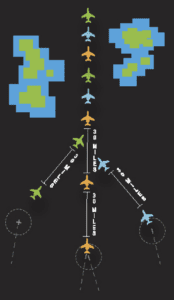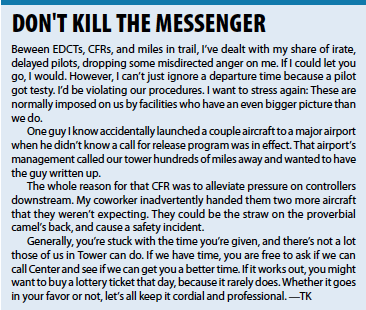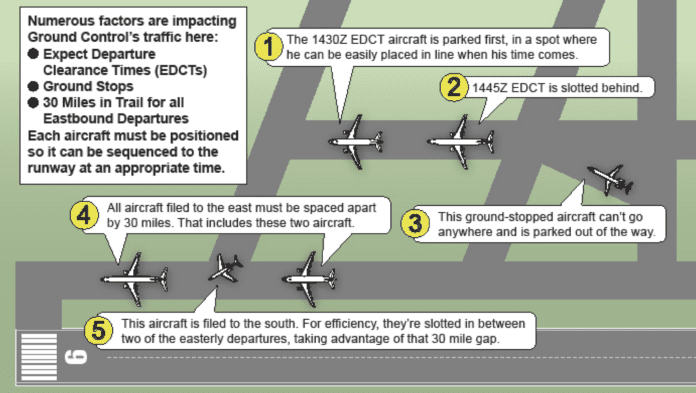In the grand scheme of air traffic control, Ground Control sometimes seems to be a supporting position. Radar’s taking fast-moving arrival streams and forging them into precise, parallel finals. Tower’s launching aircraft in the tight gaps between arrivals. Meanwhile, GC’s airplanes are … lumbering across concrete.
It may not be sexy, but Ground’s my favorite position to work. I like looking at airplanes and there they are, right outside the windows. I also like solving puzzles, and that’s where it holds its true appeal to me. Ground’s role isn’t just taking everyone to the runway willy-nilly. It’s ensuring the right airplane gets to the runway at the right time. Determining that sequence takes planning and lots of situational awareness.
Hold ‘Em Down
Ground’s traffic might be literally right outside the tower windows, but the order in which they fall often gets decided by far-off forces beyond his control. Namely, Traffic Management Initiatives.
What’s a TMI? When the ATC System Command Center and the ATC Centers determine a destination airport can’t handle the volume of traffic filed its way—due to weather, construction, etc.—they take the “initiative” and “manage” the “traffic” volume to ward off potential chaos. Using assigned departure times, they space out what would otherwise be a horde of airplanes.
The various TMIs do the same thing: Hold aircraft on the ground until their destination can take them. Expect Departure Clearance Times (EDCTs) are “wheels up” times that print out on the flight plan. They are assigned by ATC, often in collaboration with the aircraft’s company. The aircraft must depart within five minutes of that time.
Let’s say an airport can only accept 45 arrivals per hour. Are 60 planes scheduled to arrive in a particular hour and 30 in the next one? If all 60 arrived at once, 15 might be holding and burning precious gas until they can eventually land. To alleviate this, a TMI will be applied, assigning 15 of those 60 arrivals EDCTs that will have them arriving in the second hour, i.e. 45 per hour.
Then there’s a call for release program (CFR). Instead of a preassigned departure time given to the crew and the tower, the tower controller must call their overlying center’s Traffic Management Unit (TMU) to secure a release window. For maximum accuracy, we often wait until the aircraft starts its pushback. “TMU, tower, request release, Delta 1234 to Atlanta in 10 minutes.”
Center’s TMU will usually give us a small window of only two or three minutes in which we can launch the aircraft, and it could be quite far off from the time we requested. Delta may be ready in ten minutes, but there’s likely a stream of aircraft headed to ATL passing overhead right now. The nearest available gap in that line could be 30 minutes away.
The most restrictive ground delays are ground stops. If a destination airport is already slammed—for instance, it’s covered in storms and there are stacks of arrivals already holding, unable to get in—the FAA will ground stop all subsequent departures to that airport until things settle down. They’ll tell us an “expected update time” upon which they’ll either extend the ground stop or allow arrivals again. Once it opens back up, EDCT or CFR programs are often implemented to manage the rush and prevent them from getting flooded again.
Toying with Time
Can an airliner just hang out at the gate until its departure time? If a new arrival is scheduled for that gate, the airport or their company may need it vacated. The result? Ground may have a pile of aircraft that aren’t authorized to go anywhere, can’t stay where they are, and have very tight windows in which they can depart. They might even be ground-stopped and can’t depart at all for now.
Imagine I’m working Ground. I have over a dozen airliners at my terminals. It’s now 1400Z. One has a time at 1430Z, the next at 1445Z, and the third is ground-stopped. The 1445Z calls first, then the 1430Z, and then the ground-stop aircraft. Afterwards, three other aircraft—who have no TMI affecting them—call for taxi.
ATC’s supposed to be “first come, first served,” right? What if I blindly applied that here and taxied everyone to the runway in the order they called? The #1 1445Z aircraft can’t depart for another 45 minutes. Behind him, I’d have a guy with an earlier 1430Z time, who would then miss his window. Number three is an aircraft who isn’t authorized to depart. At the rear of the line are three aircraft who weren’t subject to TMIs, but will now incur massive delays because I stuck them behind aircraft that did.
“First come…” is thankfully a guideline, not a hard rule. Rather than stupidly shutting down the airport, I need to arrange these aircraft on the airport in a way that makes sense. Through experience, controllers learn which of the less-trafficked taxiways and ramps make good holding spots.

First, I pick a low-use taxiway and park the 30 minute aircraft on it. Behind them, on the same taxiway, I’ll place the 45 minute aircraft, in time-sequential order. Now, the ground-stopped aircraft is a wildcard. Their destination could open in two minutes or two hours. I choose a different taxiway and place them there, so I can peel them off independently. Meanwhile, I taxi the three unaffected airplanes out to the runway for departure.
Once a delayed aircraft is in a spot where they won’t impede movement on the airfield, they often ask to shut down their engines to conserve fuel. I normally authorize it, but ask they be fired up in time to meet their window. If a plane has a 1500Z-1503Z EDCT time and it’s 1330Z, I’d say, “Shutdown approved. Be ready to taxi at 1450Z.”
Hurry Up and Wait
Of course, EDCT/release times aren’t the only factors when sequencing. As I’m resolving the situation above, I get a call from Approach. “Center wants 30 miles in trail going out the East gate.”
What does that entail? If I have multiple departures filed out the east side of our airspace, I must ensure a following airplane doesn’t cross the eastern boundary until it’s 30 miles behind a plane in front of it. Center controllers may be dealing with weather or trying to blend streams from different airports. Like EDCTs and CFRs, it’s a method for reducing workload on controllers who are already dealing with weather and/or high traffic volume.
I’m hoping you’re familiar with the whole distance = rate x time formula. We just call it “miles per minute” in ATC. All my departures are jets, so let’s assume they’ll all be accelerating to 250 knots shortly after departure. Below 10,000, they aren’t permitted to go faster. That amounts to 4.16 miles per minute. If their speed was a constant 250 knots, that amounts to 7.2 minutes for an aircraft to travel 30 miles.
Now, do we wait exactly 7.2 minutes before launching the next aircraft? No, since our aircraft speeds aren’t constant. Freshly departed jets don’t reach 250 knots until a couple minutes into their flight. However, they also climb fast. Reaching 10,000 feet, they accelerate to their much faster cruising speed, opening space quickly—before they’ve traveled 30 miles, they’re clocking well over 300 knots.
There are other factors in play here too, like the runway in use, the performance of each jet type (not all are quite so spry) or the number of turns on the departure procedure they’re assigned. In our example here, let’s just say this: to achieve 30 MIT (miles in trail), the next aircraft should be rolling down the runway around six minutes after the previous departure.
I examine the three flights taxiing to the runway. The first two are east departures, subject to the MIT, and the last is a south departure. As the sequence currently stands, after the first plane goes, the second east aircraft must sit an extra six minutes before departing. That unjustly delays the south flight sitting behind him by that same six minutes. As attested by anyone who’s ever bolted across a busy terminal on Thanksgiving weekend to make a connecting flight (I’m raising my hand here) a couple minutes can make all the difference.
How do I minimize those unnecessary delays? By readjusting my sequence. I tell the second east departure “hold position” and then slot the south flight ahead of him. Once the first east flight departs, the south flight can depart in that otherwise dead six minute gap. No delay for him. Then the second east flight departs on time to fall 30 miles behind the first aircraft.
tell the second east departure “hold position” and then slot the south flight ahead of him. Once the first east flight departs, the south flight can depart in that otherwise dead six minute gap. No delay for him. Then the second east flight departs on time to fall 30 miles behind the first aircraft.
Final Assembly
Time passes, and more airliners are pushing back. They’re all easterly departures. Remember my 1430Z and 1445Z EDCT airplanes? It turns out they’re both easterly departures too.
The math is king here. Right now, it’s 1412Z. 18 minutes (until 1430Z) divided by six minutes between each aircraft equals three departure slots. So, to make their window, the 1430Z flight must be number three in line at the runway.
I ensure he’s fired up and ready to taxi. Two other departures taxi out. I tell him to follow them to the runway, and he falls in line.
What about the 1445Z departure? His EDCT is 15 minutes after the 1430Z flight. 15 divided by six minutes is 2.5. That leaves me with departure slots at 1436Z and at 1442Z to start, with his time only three minutes afterwards. If I departed him right at 1445Z I wouldn’t have the 30 miles in trail requested behind the 1442Z flight.
However, I’ve got room to play here. With an EDCT, he can go up to five minutes before or after his time, giving him a window between 1440Z and 1450Z. I can round that 2.5 in two directions. Rounding up to three will have him depart at 1448Z. Alternately, I can round down, and make him the 1442Z departure. Either way is within the EDCT ±five-minute window.
I’m very much aware that this flight’s already been waiting a while, so of course I give him the earlier 1442Z slot. I taxi one more departure after the 1430Z flight, and then tell the 1445Z flight to follow him.
One last loose end: the ground stop aircraft. Just then, I get a notification that their ground stop is cancelled, and is replaced with a call for release program. He’s also an east departure, so the 30 MIT applies. At this moment I have six planes en route to the runway: two non-EDCT flights, then the 1430Z, another non-EDCT flight, then the 1445Z (who Tower should launch around 1442Z.)
I call Center and request a time at 1448Z, and—miracle of miracles—they give me a release window from 1448Z-1451Z. I advise the aircraft of the situation. Once he fires up an engine, I get him in line.
At this point, all my aircraft are exactly where they need to be. This doesn’t just benefit the pilots. As a member of the control tower team, I aim to make my Tower controller’s life easy. The pilots all know what times to expect. Tower’s got all of their times written on the flight progress strips in front of him. They’re all in the appropriate order. All he needs to do is clear them for takeoff.
Ground delay programs and miles in trail suck. Controllers wish they could let everyone go the second they’re ready, but there’s often not much we can do about restrictions from on high. Ground just tries to ensure you’re informed and at the runway when it’s your time to go.





